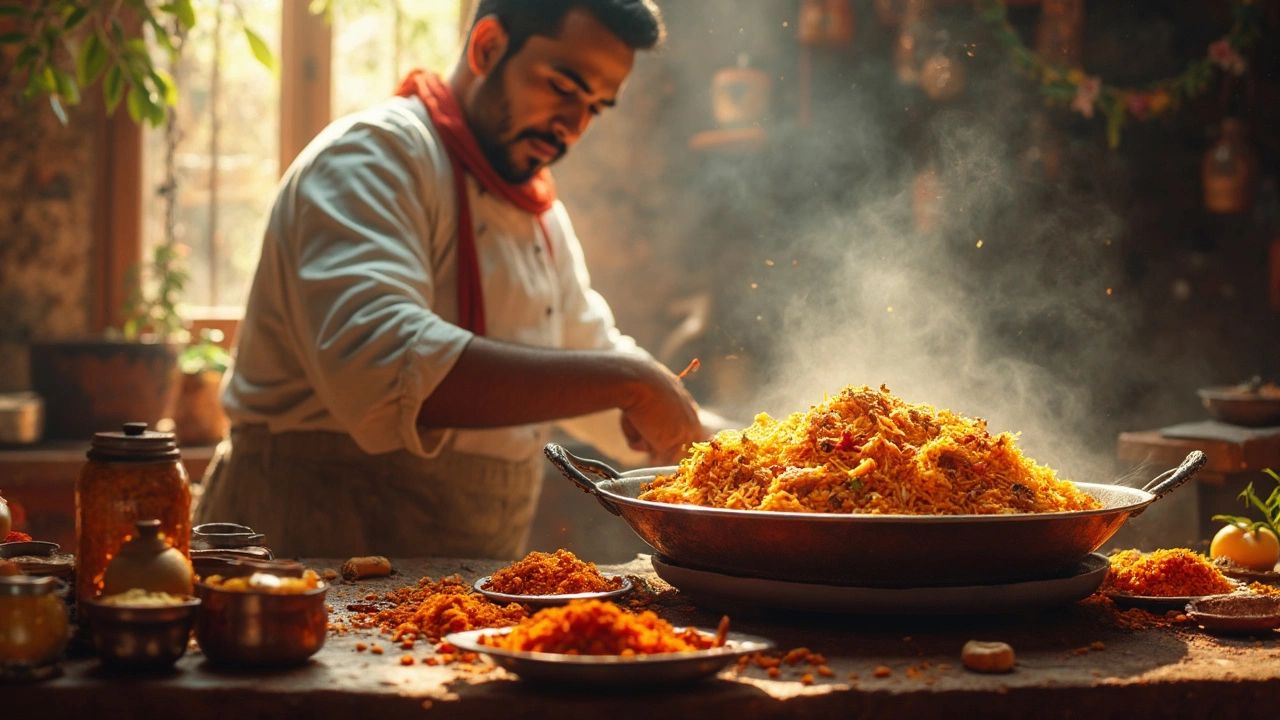What Makes Biryani Juicy: Secrets to Perfect Flavors
 Mar, 22 2025
Mar, 22 2025
Biryani isn't just rice and meat tossed together; it's a symphony of flavors that need to hit the right notes. Ever wonder why some biryani is mouth-wateringly juicy while others are dry and lackluster? It boils down to technique, my friends. It’s about getting every detail right, from marination to layering. So, if you've been struggling with biryani that just doesn't hit the mark, you're in the right place.
The juiciness of biryani starts with good marination. The idea is to let the meat drink up those spices and yogurt so it turns tender and flavorful when cooked. Think of marination as laying the groundwork for success. A good few hours—or even overnight—lets the flavors really seep in. But that's just the beginning.
- What Makes Biryani Juicy
- Importance of Marination
- Layering Techniques
- Balancing Spices and Moisture
- Tips for Perfect Biryani Every Time
What Makes Biryani Juicy
Creating a juicy biryani isn't just luck; it's downright science with a bit of art thrown in. Here are the essential elements that ensure each bite is as delightful as the last.
Marination Magic
First up, the marination process. This is where flavor meets tenderness. When you marinate the meat, typically with yogurt and a mix of spices, it not only adds flavor but also softens the meat. The acidity in the yogurt and the enzymes in certain spices act like tenderizers. Think of it as giving the meat a long, relaxing spa day before it joins the party.
The Importance of Well-Cooked Rice
The rice has to be parboiled just right—not fully cooked because it gets finished in the pot. The trick is to boil it with whole spices and salt so each grain is flavorful on its own. Don't rush this step; it’s where a lot of the magic happens.
Layering Techniques
Ah, the art of layers! This isn't a casserole where you mix everything up. No, it's about carefully layering the rice and marinated meat so that the moisture and flavors move between them while cooking. This is often done in a vessel called a 'Handi,' and requires an eye for balance. You want a bit of rice, a bit of meat, and a pat of ghee or butter to top it all off, so each layer shares the love.
Sealing the Deal
Sealing the pot with dough or a tight-fitting lid is crucial. It traps the steam and retains the moisture, allowing everything inside to cook evenly without drying out. This ancient technique called 'Dum' cooking is what separates the ordinary from the extraordinary.
Balancing Spices and Moisture
Last but not least, finding the right balance of spices and moisture is vital. Too much liquid can make it soggy, too little can dry it out. Keep the moisture in check with just the right amount of broth, yogurt, or marinade. And remember, the quality of your spices can make or break your dish. Always opt for fresh, whole spices for that extra punch!
Importance of Marination
When it comes to making a mouth-watering biryani, marination is like your backstage crew making sure the star of the show—your meat—shines brightly. Good marination is more than just throwing ingredients together; it’s about creating a flavor bomb that soaks into the meat, making it tender and juicy.
Why does marination matter so much? Well, the primary purpose is to tenderize the meat. Ingredients like yogurt and lemon juice break down proteins, ensuring that once your biryani is cooked, you're not chewing on leather.
The Magic Ingredients
The basic marination includes a mix of yogurt, spices like garam masala, ginger-garlic paste, and sometimes lemon juice. Each ingredient plays a role. Yogurt acts as the tenderizer while spices infuse flavor. However, it's important to find that perfect balance where flavors mingle without overpowering each other.
Timing Is Key
Think of marination time as flavor investment. More time equals more flavor. Ideally, you should marinate your meat for at least 2 hours, but if you're after that soul-satisfying juicy biryani, try overnight. It makes a world of difference!
Quick Survey on Marination Times
| Marination Time | Flavor Quality |
|---|---|
| 30 minutes | Basic flavor |
| 2 hours | Balanced and tender |
| Overnight | Rich and juicy perfection |
So, next time you're planning to whip up a batch of biryani, don't rush the marination step. Give it love, give it time, and your biryani will sing with flavors!

Layering Techniques
Biryani isn’t just a one-pot wonder; it’s all about the layers. Think of it like assembling a really comforting and aromatic parfait. Getting the layering techniques right ensures every bite is packed with flavor and juiciness.
You want to start by spreading a layer of cooked rice at the bottom of your pot. This acts as a barrier to prevent the bottom from burning. Then, you add a layer of marinated, partially cooked meat. This is where the magic starts to happen. The meat releases its juices, which mix with the rice. Another layer of rice follows, trapping the flavor steam.
"The art of biryani lies in its layers. Each layer should stand out but also work in harmony," said renowned chef Mehreen Karim, who swears by her mother’s biryani technique.
Once you’ve built a few layers, topping it all off with fried onions, ghee, saffron water, and a sprinkle of mint and coriander gives it that signature touch. Let’s not forget a hint of rose water for an extra aromatic kick. The steam does the rest, allowing flavors to blend and the biryani to stay juicy.
Pro Tip: The Dum Technique
Use the 'dum' method—cover the pot with a tight-fitting lid and seal it with a dough, or use foil to trap the steam. Cook on low heat. This slow cooking process helps in flavor absorption and keeping everything moist.
Remember, the proportion of rice to meat should be just right—typically aiming for about a 2:1 ratio, depending on how meaty you want it.
Layering Order
This tried and tested order brings out the best in your biryani:
- Layer 1: Cooked rice
- Layer 2: Marinated meat
- Layer 3: Cooked rice
- Layer 4: Toppings (fried onions, saffron water, and herbs)
Layering doesn’t just make biryani juicy—it makes it a feast for the senses. Make each layer with love, and you’re bound to have a dish that’s memorable both in taste and aroma.
Balancing Spices and Moisture
Nailing that perfect biryani flavor is all about getting the right balance of spices and moisture. Too much spice can overpower, while too little can make it bland. And let’s not even get started on how a dry biryani can ruin your meal! So, how can you balance these two crucial elements?
First off, let's talk about spices. Biryani is a feast for the palate, and each spice plays its role. The basic spices like cumin, coriander, and garam masala are a must-have. But don't forget the supporting cast: cloves, cardamom, and bay leaves add depth. Fresh ingredients like chopped mint and cilantro aren't just for garnish—they elevate the dish. It's all about creating layers of flavor.
The Role of Moisture
Now, onto the moisture component. The rice-to-water ratio is crucial. Too much water, and you end up with a mushy mess. Too little, and you risk burning it. Generally, a 1:1.5 ratio of basmati rice to water works wonders. But if you’re cooking in one pot, the juices from the marinated meat will help, so adjust accordingly.
Combining the Two
Once you've marinated, layered, and added your spices, seal the pot with foil or a tight-fitting lid to trap steam. This is where the magic happens! The aromatic steam not only cooks the rice but infuses it with the spice blend, making the biryani juicy and flavorful. If you’re feeling fancy, adding a splash of saffron mixed with warm milk can also add color and richness.
| Spice | Moisture Balance |
|---|---|
| Cumin | Enhances marination |
| Cardamom | Adds aroma without extra dampness |
| Mint and Cilantro | Provide fresh moisture |
So, there you go! Get the spice blend and moisture just right, and you’ll find yourself with a biryani that's not just a dish, but an experience.

Tips for Perfect Biryani Every Time
Nailing a great juicy biryani isn’t just a one-time affair; it’s an art you can master with a few simple tricks. Whether you’re a newbie or a seasoned cook, these tips will help transform your biryani game.
1. Marination Magic
Start with a solid marination base. Use a mix of yogurt, lemon juice, spices, and ginger-garlic paste for the meat. Let it sit for at least four hours, but overnight is even better if you have the time. This step ensures your meat is soaked with flavor and tender.
2. Perfect Rice Every Time
The rice needs to be semi-cooked, around 70% done, before you layer it with the meat. Boil the rice with whole spices like bay leaves, cloves, and cinnamon for added aroma. Remember to rinse the rice thoroughly before cooking to remove excess starch.
3. Layer Like a Pro
Layering is where the magic happens. Alternate between the marinated meat and rice layers, and drizzle saffron milk or rose water on top for fragrance. A sprinkle of fried onions adds an irresistible crispiness.
4. Mind the Pot
Choose a heavy-bottomed pot to prevent burning. Seal the lid with a dough ring so the steam stays trapped inside—this is called the 'dum' method. Cook on a low flame so that the flavors meld together slowly.
5. Spice It Right
A good biryani is balanced in spices. Too much can be overwhelming, so go gentle with your hand. Adjust the spiciness according to your taste, and remember that the right amount of salt can make or break the dish.
6. Rest Before Serving
Once cooked, give your biryani at least 15 minutes to rest. This allows the flavors to settle and makes each bite more harmonious.
Equipped with these insights, get ready to impress everyone at the dinner table. Biryani isn't just a dish; it's an experience. Happy cooking!
